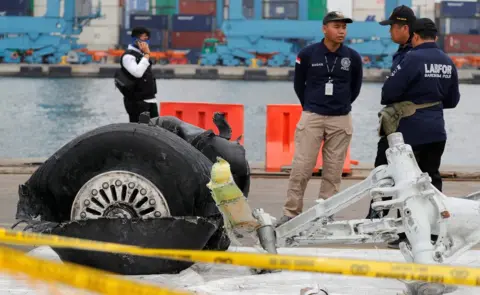Lion Air crash: Jet had airspeed problems on final four flights
A passenger jet that crashed into the sea near Indonesia last week had an airspeed indicator problem on its final four flights, officials say.
The damage to the device, which tells pilots how fast their planes are travelling, was revealed after the recovery of a "black box" recorder.
Lion Air flight JT 610, carrying 189 people, crashed soon after taking off from Jakarta, the Indonesian capital.
Angry relatives confronted Indonesian officials at a conference on Monday.
They wanted to know why the plane was allowed to fly and demanded there be no let up in recovery efforts. The cause of the crash is still unclear.
"We are the victims here. Imagine if you were in our position," said Najib Fuquoni, a relative of a victim.
Lion Air's founder, Rusdi Kirana, attended the meeting.
At one point, families demanded that he stood up. He did not speak but clasped his hands in prayer and bowed his head.

Questions arise from recorded fault
By Theo Leggett, BBC international business correspondent
The suggestion that the Lion Air plane had a defective airspeed indicator is a significant development. The aircraft's erratic behaviour during its final flight, and reports of an issue during a previous journey, had already prompted speculation that this could have been an issue.
 Reuters
ReutersAirspeed is measured using sensors called pitot tubes, which record pressure on the wing or front surface of the aircraft. This is compared to pressure readings obtained from a so-called "static port" on another part of the aircraft. With corrections, the difference between the two can be used to calculate airspeed.
Pitot tubes, however, can become blocked - for example due to icing. Such instances can cause erratic airspeed readings, which in turn can confuse pilots and affect the way in which the aircraft is flown, possibly leading to accidents.
In 2009, for example, an Air France flight went down off the coast of Brazil. Blocked pitot tubes triggered a chain of events in which the pilots became confused and disorientated and lost control. In every other respect the aircraft was working perfectly.
These are still early days in the investigation and more information is needed. But if unreliable airspeed readings were a factor, key questions will be: what was the cause - poor design or poor maintenance procedures, for example - and why previous problems were apparently not rectified.

What is the problem with the instruments?
Logs obtained by the BBC have already shown that on the Boeing 737 Max's penultimate flight, airspeed readings were unreliable.
But Indonesia's National Transportation Safety Committee now says there were also problems on the previous two flights, as well as the final, fatal journey.
 Getty Images
Getty Images EPA
EPAThey did not say whether the problems stemmed from a mechanical or maintenance issue, or whether the faulty meter was a factor in the crash.
"Currently we are looking for the cause of problem," said investigator Nurcahyo Utomo, Associated Press reported.
"Whether the trouble came from its indicator, its measuring device or sensor, or a problem with its computer. This is what we do not know yet and we will find it out".
Indonesia's government ordered an inspection of all the country's Boeing 737 Max planes following the crash.
What do we know about the final flight?
The jet plummeted into the Java Sea - no survivors have been found, nor has the body of the Boeing 737.
The plane was making a one-hour journey to the western city of Pangkal Pinang when it went down.
The pilot had asked air traffic control for permission to turn back to the airport but then contact was lost.


Victims' relatives are still waiting to receive the remains of loved ones. Scores of body bags have been gathered but so far only 14 individuals have been identified.
Search teams are also still trying to find the plane's cockpit voice recorder.
